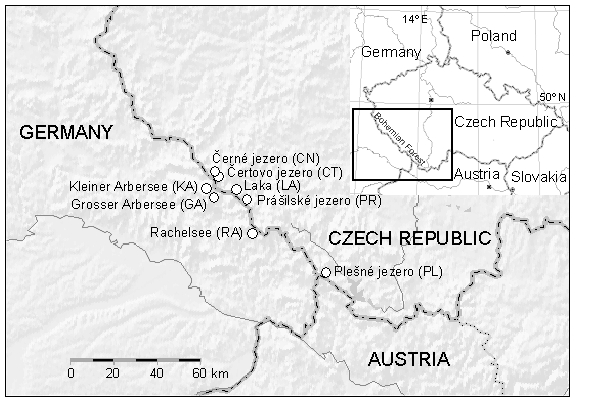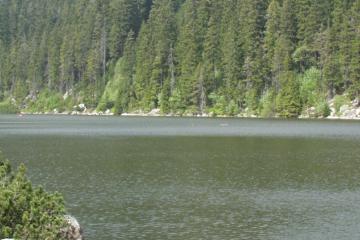The Bohemian Forest (Šumava in Czech, Böhmerwald in German) in Central Europe is among the most acidified lake districts in the world. Deposition of sulphur and nitrogen compounds in the area rapidly increased between 1950 and 1980, and reached a maximum in mid the 1980s. Owing to long-term occasional hydrobiological research and palaeolimnological studies, we are able to document the significant changes in the lake water chemistry and biodiversity (in particular the conspicuous reduction in crustacean and/or insect species in some lakes, as well as the extinction of fish). During the 1990s, acidic deposition decreased substantially, and its current levels are comparable to the early 20th century for SO42– and NH4+, and to the mid 1960s for NO3–. The decline in acidic deposition has resulted in a partial recovery of the Bohemian Forest lakes, as well as in an improvement of the Norway spruce physiology in their catchments.
Therefore, the Bohemian Forest lakes represent excellent LTER sites. Available historical data (biota since 1871) and regular monitoring (biota and chemistry since 1984) provide a valuable background for long-term ecological research of the catchment–lake ecosystems that currently focuses on (i) chemical reversal and biological recovery of the lakes, (ii) acidification effects on in-lake nutrient cycling, (iii) climatic effects on water chemistry, and (iv) catchment processes, including soil biogeochemistry and acidification impacts on vegetation (mountain spruce forests).
Two of the lakes, the most acidified Čertovo Lake (CT) and the mesotrophic (phosphorus rich) Plešné Lake (PL), have been selected for detail mass-budget studies since 1998. Hydrology, water and precipitation chemistry, soil and sediment biochemistry, litter composition, and climatic variables have been regularly monitored with the aim to evaluate cycling of nutrients (C, N, P, Si) and ecologically important metals (Al, Fe) within the catchment–lake ecosystems.
Eight small glacial lakes are situated on forested slopes of the central summit of the Bohemian Forest (Böhmerwald, Šumava) along the historical border between Bavaria and Bohemia.

| Lake | CN | CT | RA | PL | KA | PR | GA | LA |
|---|---|---|---|---|---|---|---|---|
| Latitude (N) | 49°11´ | 49°10´ | 48°58´ | 48°47´ | 49°08´ | 49°05´ | 49°06´ | 49°07´ |
| Longitude (E) | 13°11´ | 13°12´ | 13°24´ | 13°52´ | 13°09´ | 13°24´ | 13°07´ | 13°20´ |
| Altitude (m a.s.l.) | 1008 | 1027 | 1071 | 1087 | 917 | 1079 | 935 | 1085 |
| Lake area (ha) | 18.8 | 10.7 | 4.8 | 7.2 | 7.4 | 4.2 | 7.9 | 2.4 |
| Catchment area (km)2 | 1.24 | 0.89 | 0.58 | 0.67 | 2.79 | 0.65 | 2.58 | 1.02 |
| Max. depth (m) | 40 | 35 | 13 | 18 | 10 | 17 | 17 | 3.5 |
| Lake volume (106 m3) | 2.92 | 1.86 | 0.25 | 0.55 | 0.26 | 0.35 | 0.49 | 0.05 |

 Supported by Advance eLTER project number 739558
Supported by Advance eLTER project number 739558